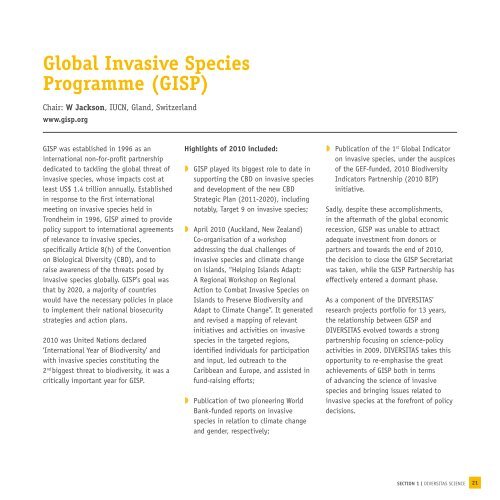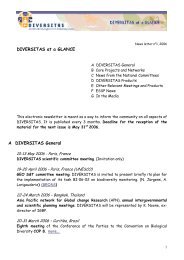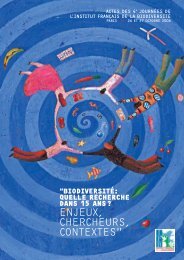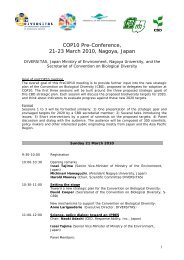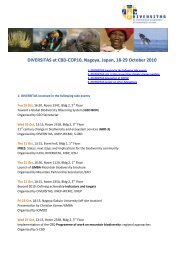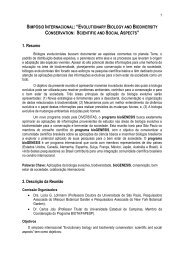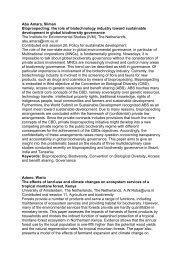Annual Report 2010-11 - Global Invasive Species Programme - GISP
Annual Report 2010-11 - Global Invasive Species Programme - GISP
Annual Report 2010-11 - Global Invasive Species Programme - GISP
Create successful ePaper yourself
Turn your PDF publications into a flip-book with our unique Google optimized e-Paper software.
<strong>Global</strong> <strong>Invasive</strong> <strong>Species</strong><strong>Programme</strong> (<strong>GISP</strong>)Chair: W Jackson, IUCN, Gland, Switzerlandwww.gisp.org<strong>GISP</strong> was established in 1996 as aninternational non-for-profit partnershipdedicated to tackling the global threat ofinvasive species, whose impacts cost atleast US$ 1.4 trillion annually. Establishedin response to the first internationalmeeting on invasive species held inTrondheim in 1996, <strong>GISP</strong> aimed to providepolicy support to international agreementsof relevance to invasive species,specifically Article 8(h) of the Conventionon Biological Diversity (CBD), and toraise awareness of the threats posed byinvasive species globally. <strong>GISP</strong>’s goal wasthat by 2020, a majority of countrieswould have the necessary policies in placeto implement their national biosecuritystrategies and action plans.<strong>2010</strong> was United Nations declared‘International Year of Biodiversity’ andwith invasive species constituting the2 nd biggest threat to biodiversity, it was acritically important year for <strong>GISP</strong>.Highlights of <strong>2010</strong> included:ZZ<strong>GISP</strong> played its biggest role to date insupporting the CBD on invasive speciesand development of the new CBDStrategic Plan (20<strong>11</strong>-2020), includingnotably, Target 9 on invasive species;ZZApril <strong>2010</strong> (Auckland, New Zealand)Co-organisation of a workshopaddressing the dual challenges ofinvasive species and climate changeon islands, “Helping Islands Adapt:A Regional Workshop on RegionalAction to Combat <strong>Invasive</strong> <strong>Species</strong> onIslands to Preserve Biodiversity andAdapt to Climate Change”. It generatedand revised a mapping of relevantinitiatives and activities on invasivespecies in the targeted regions,identified individuals for participationand input, led outreach to theCaribbean and Europe, and assisted infund-raising efforts;ZZPublication of two pioneering WorldBank-funded reports on invasivespecies in relation to climate changeand gender, respectively;ZZPublication of the 1 st <strong>Global</strong> Indicatoron invasive species, under the auspicesof the GEF-funded, <strong>2010</strong> BiodiversityIndicators Partnership (<strong>2010</strong> BIP)initiative.Sadly, despite these accomplishments,in the aftermath of the global economicrecession, <strong>GISP</strong> was unable to attractadequate investment from donors orpartners and towards the end of <strong>2010</strong>,the decision to close the <strong>GISP</strong> Secretariatwas taken, while the <strong>GISP</strong> Partnership haseffectively entered a dormant phase.As a component of the DIVERSITAS’research projects portfolio for 13 years,the relationship between <strong>GISP</strong> andDIVERSITAS evolved towards a strongpartnership focusing on science-policyactivities in 2009. DIVERSITAS takes thisopportunity to re-emphasise the greatachievements of <strong>GISP</strong> both in termsof advancing the science of invasivespecies and bringing issues related toinvasive species at the forefront of policydecisions.SECTION 1 I DIVERSITAS SCIENCE 21


